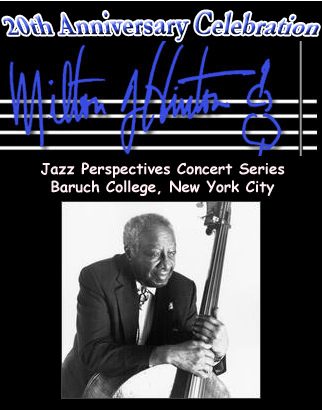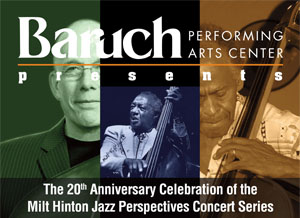The Marlowsphere (#7)
The celebration of the arts generally and jazz in particular in April is apparently a burgeoning, or perhaps I should say, a re-surging happening. April is Jazz Appreciation Month, a yearly celebration inaugurated by the Smithsonian 11 years ago. April 17 was “Support Arts Advocacy Day,” a national day of action in support of the arts initiated by the Performing Arts Alliance, a national co-sponsor. Further, as an earlier blog reported, April 30 has been designated as International Jazz Day by the world-wide organization UNESCO with no less than jazz legend and Grammy-winner Herbie Hancock leading the charge. And in keeping with the annual recognition of jazz as an important cultural contribution trend, the Jazz Journalists Association has just announced the nominees for its annual awards fete (to be held in June) and a “blogathon” that runs the month of April.
Clearly, April is a month full of recognition and celebration of jazz and the arts in general. But an appreciation of the arts–never mind the long-term social and economic benefits of the arts to the individual and the community at large–is not something to be focused on during one month out of the year. It is an endeavor that requires year-round emphasis.
Celebrating the 20th Year of the Milt Hinton Jazz Perspectives Series
 Here’s a case in point. As it happens, 2011-2012 marks the 20th anniversary of the Milt Hinton Jazz Perspectives Series at Baruch College (The City University of New York). I have been fortunate to curate this series as co-chair since 2000.
Here’s a case in point. As it happens, 2011-2012 marks the 20th anniversary of the Milt Hinton Jazz Perspectives Series at Baruch College (The City University of New York). I have been fortunate to curate this series as co-chair since 2000.
This series, named in honor of master bassist Milt “the Judge” Hinton, who taught a weekly jazz workshop at Baruch College, has presented some of the crème de la crème in the jazz world: from Hinton himself, to Tito Puente, singer Ruth Brown, Regina Carter, Dr. Billy Taylor, The Mingus Big Band, The Heath Brothers, The Latin Jazz All Stars, pianist Roberta Piket, Bobby Sanabria, Chris Washburne’s SYOTOS, the Turtle Island String Quartet, bassist Rufus Reid, Lonnie Plaxico, Andy Statman, singer Carla Cook, The McCollough Sons of Thunder, Roberta Gambarini, jazz harpist Edmar Castaneda, and Andy LaVerne, among many others, including several jazz journalists.
For the 20th anniversary, the Milt Hinton Committee, working with John Malatesta, Managing Director of the Baruch Performing Arts Center, spent the better part of the 19th season planning ways to not only bring greater on-campus recognition to the series, but also to bring jazz into the classroom.
On The Campus
The result was an on-campus, five-event series in Baruch’s Engelman Recital Hall and the college’s Sidney Mishkin Gallery.
On September 22, through the good offices of committee member (and teaching colleague) Prof. Bridgett Davis, we arranged for Lolis Eric Elie, writer of the hit HBO series “Treme,” to be in conversation with Siddhartha Mitter, music critic for The Boston Globe. Many students as well as faculty and community residents filled the hall.
Between November 10-December 12, 2011, the Sidney Mishkin Gallery, curated by committee colleague Dr. Sandra Kraskin, hosted an exhibit of Milt Hinton’s many photographs (black and white and color). In addition to a master bassist, he was also an avid, and very professional photographer.
On November 17, 2011, we mounted a film screening and discussion of “Keeping Time: The Life, Music, and Photographs of Milt Hinton,” an excellent film documentary produced by David G. Berger and Kate Hirson.
December 5, 2011, the series presented “Jazz Bassist Jay Leonhart & Friends: trombonist Wycliff Gordon, saxophonist Houston Person, drummer Bernard Purdy, and pianist John Colianni.” This was a sold-out gala event that included a post-performance reception.
And on March 4, 2012, the 20th anniversary celebration closed with a performance by the Harvard Jazz Band, under the direction of Thomas G. Everett, which featured bassist Cecil McBee in a special tribute to Hinton.
In The Classroom: A Two-Semester Look At Jazz
As part of the 20th anniversary celebration, I was able to arrange for an honors seminar–“Jazz: Cultural Touchstone of the 20th Century”–in the fall 2011 semester. The most exciting aspect of the semester was having the opportunity to bring in guest speakers to the classroom on a wide variety of subject dealing with jazz. The guest speakers included:
- Jazz journalist Larry Blumenthal, speaking on Katrina and New Orleans
- Multi-Grammy nominee drummer Bobby Sanabria on the origin and history of clavé
- Prof. Philip Lambert of Baruch’s Department of Fine and Performing Arts on the relationship between classical music and jazz
- Prof. Myron Schwartzman (retired) on artist Romare Beardon. Many of Beardon’s themes were jazz-oriented
- Yulun Wang, co-founder of Pi Recordings on the vagaries of the recording and marketing aspects of jazz
- Jazz journalist David Adler on the intersect between jazz and hip-hop
- Author/radio broadcaster Sally Placksin on women in jazz
- Photographer Enid Farber on jazz performers as subjects
- Author and investment analyst Kabir Seghal on his book Jazzocracy
The students also spent an evening at the Jazz Standard courtesy of Seth Abramson, Director of Programming, listening to the Mingus Orchestra perform. In addition to a visit by the students to the Mishkin Gallery to view the Hinton photo exhibit, I also had the opportunity to present a class on jazz in television commercials.
The students wrapped up the semester with a major paper on a variety of jazz-related subjects and an oral presentation (with multimedia elements) based on their final paper. The presentations were, in the main, outstanding. At the beginning of the semester most of the students had no clue what jazz was and its cultural significance. I think the seminar made a few converts by semester’s end.
The spring 2012 semester offered another opportunity to focus not only on jazz, but on music in general. While planning for the 2011-2012 academic year I suggested a journalism course on “Covering the New York Music Scene.” The course quickly filled up to capacity (24 students).
I took the “guest speaker” approach with this course as well. By the end of the semester the students will have been treated to: Dan Wakin, Dance & Culture, The New York Times; Andrey Henkin, co-founder, The New York City Jazz Record; Jean Cook, The Future of Music Coalition; Will Hermes, Freelance Writer/Author of Love Goes To The Building on Fire and senior editor Rolling Stone; and Susan Dadian of Chamber Music America.
By semester’s end, the students, virtually all journalism majors, will have written and presented papers on: “Why Is Music Important?”; an interview with a musician; a CD review; a live performance review; a profile of a New York City-located music organization; and a book review. A final paper will deal with some issue facing the New York music business. They also will have identified print and online publications in musical genres ranging from jazz to opera to country and western.
Bringing the Outside World to the Classroom and Vice Versa
Bringing world class musicians to the Hinton Series and music professionals of various stripes into the classroom is just one half of the equation of exposing students to not just jazz, but also the larger world of the fine and performing arts. The other half is challenging students to go beyond–way beyond–the Internet and other electronic media to explore the outside world of music. The Hinton Series and concomitant courses attempt to accomplish this.
However, while it is very worthwhile designating a day or a month in celebration of the arts as a way of bringing focus to the importance of the arts, it is just as important to emphasize the arts year-round. The social and economic impact of the arts doesn’t happen on one day or in one month. It is a lifetime cultural constant.
Please share your comments by writing to Eugene Marlow at meiienterprises@aol.com.
Eugene Marlow
April 22, 2012
© Eugene Marlow 2012


